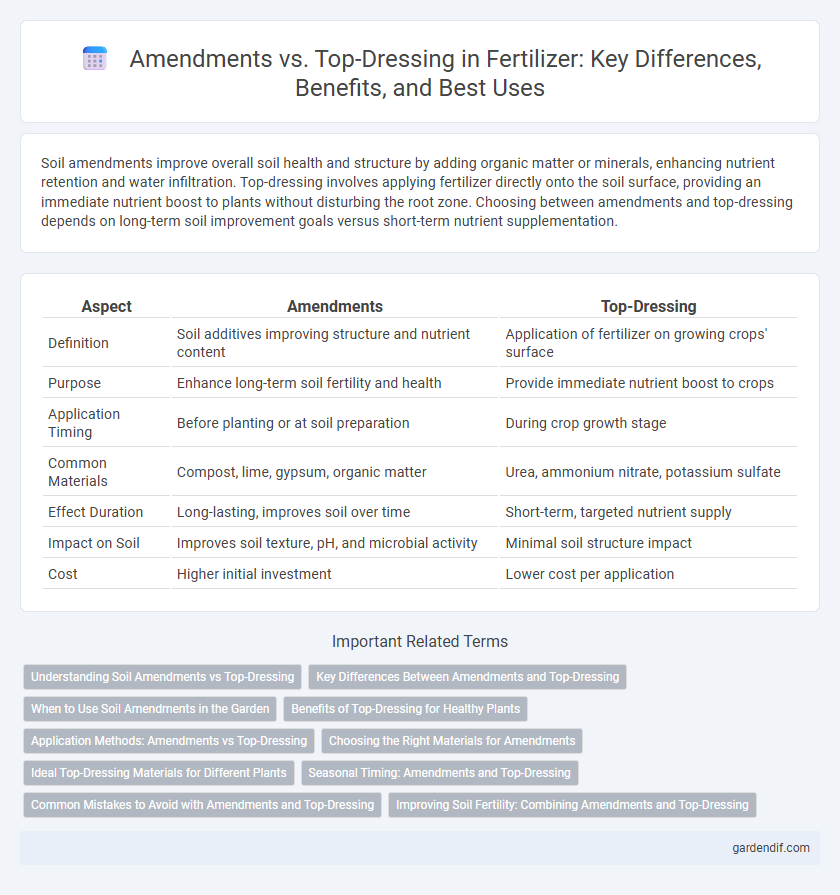
Amendments vs Top-dressing Illustration
Soil amendments improve overall soil health and structure by adding organic matter or minerals, enhancing nutrient retention and water infiltration. Top-dressing involves applying fertilizer directly onto the soil surface, providing an immediate nutrient boost to plants without disturbing the root zone. Choosing between amendments and top-dressing depends on long-term soil improvement goals versus short-term nutrient supplementation.
Table of Comparison
| Aspect | Amendments | Top-Dressing |
|---|---|---|
| Definition | Soil additives improving structure and nutrient content | Application of fertilizer on growing crops' surface |
| Purpose | Enhance long-term soil fertility and health | Provide immediate nutrient boost to crops |
| Application Timing | Before planting or at soil preparation | During crop growth stage |
| Common Materials | Compost, lime, gypsum, organic matter | Urea, ammonium nitrate, potassium sulfate |
| Effect Duration | Long-lasting, improves soil over time | Short-term, targeted nutrient supply |
| Impact on Soil | Improves soil texture, pH, and microbial activity | Minimal soil structure impact |
| Cost | Higher initial investment | Lower cost per application |
Understanding Soil Amendments vs Top-Dressing
Soil amendments improve soil structure, nutrient content, and water retention by integrating organic matter or minerals deeply into the soil before planting, fostering long-term soil health. Top-dressing involves applying fertilizers or nutrients directly to the soil surface or plant base during the growing season to provide immediate nutrient uptake and correct deficiencies. Understanding the differences helps optimize fertilizer application timing and enhances crop yields by addressing both soil quality and plant nutritional needs effectively.
Key Differences Between Amendments and Top-Dressing
Amendments improve soil structure and nutrient content by being mixed directly into the soil before planting, enhancing long-term soil fertility. Top-dressing involves applying fertilizer or nutrients on the soil surface or around established plants to provide immediate nutrient availability during the growing season. Key differences include the timing of application, method of incorporation, and duration of nutrient release, with amendments offering sustained benefits while top-dressing delivers rapid nutrient uptake.
When to Use Soil Amendments in the Garden
Soil amendments are best used before planting to improve soil structure, increase nutrient retention, and balance pH levels, ensuring optimal root development and plant health. Incorporating organic matter such as compost or peat moss during soil preparation enhances microbial activity and moisture retention. Top-dressing is more effective during the growing season to supply nutrients directly to the plant roots without disturbing established plants.
Benefits of Top-Dressing for Healthy Plants
Top-dressing enhances nutrient availability by delivering essential elements directly to the soil surface, promoting rapid absorption and supporting vigorous plant growth. It improves soil structure and moisture retention, reducing nutrient leaching and fostering a stable root environment. Applying fertilizer as a top-dress ensures timely nutrient supply, which leads to healthier, more resilient plants and increased crop yields.
Application Methods: Amendments vs Top-Dressing
Amendments are incorporated into the soil before planting to improve soil structure, nutrient content, and pH balance, providing a long-term nutrient reservoir. Top-dressing involves applying fertilizer directly to the soil surface around growing plants, targeting immediate nutrient absorption and rapid response. The choice between amendments and top-dressing depends on crop type, growth stage, and soil health requirements, optimizing nutrient efficiency and plant development.
Choosing the Right Materials for Amendments
Selecting the right materials for soil amendments involves evaluating organic options like compost and manure versus inorganic sources such as lime or gypsum to improve soil structure and nutrient availability. Organic amendments enhance microbial activity and water retention, while inorganic amendments correct pH and replenish specific minerals essential for crop growth. Matching amendment types to soil test results and crop requirements ensures optimal nutrient balance and long-term soil health.
Ideal Top-Dressing Materials for Different Plants
Ideal top-dressing materials vary based on plant type and soil needs, with nitrogen-rich fertilizers like urea favored for leafy vegetables to promote rapid growth. For fruiting plants, balanced NPK fertilizers or organic options such as composted manure enhance yield and fruit quality. Acid-loving plants benefit from top-dressing with sulfur or acidic organic matter to maintain optimal soil pH and nutrient availability.
Seasonal Timing: Amendments and Top-Dressing
Amendments are typically applied before or during soil preparation, improving soil structure and nutrient availability for the entire growing season. Top-dressing is used mid-season or during active plant growth to supply nutrients immediately to crops and correct deficiencies. Timing these applications according to crop needs maximizes nutrient uptake efficiency and supports optimal plant development.
Common Mistakes to Avoid with Amendments and Top-Dressing
Common mistakes with fertilizer amendments include over-application that disrupts soil pH and nutrient balance, leading to poor plant health. In top-dressing, uneven distribution and ignoring soil nutrient tests often cause ineffective nutrient uptake and wasted fertilizer. Avoid using amendments without proper soil analysis and applying top-dressing too close to plant stems to prevent root burning.
Improving Soil Fertility: Combining Amendments and Top-Dressing
Soil fertility improves significantly when amendments and top-dressing are used together, as amendments enrich the soil structure and nutrient content over time while top-dressing provides immediate nutrient availability to plants. Organic amendments like compost and biochar enhance microbial activity and long-term nutrient retention, whereas top-dressing with nitrogen-rich fertilizers such as urea or ammonium nitrate boosts plant growth during critical stages. Integrating these practices optimizes nutrient cycling, increases soil organic matter, and supports sustainable crop yields.
Amendments vs Top-dressing Infographic

 gardendif.com
gardendif.com